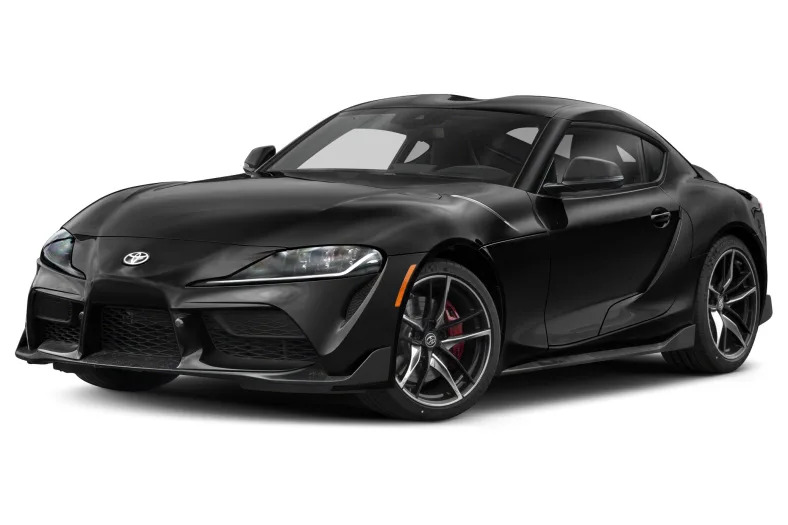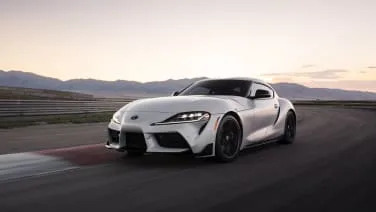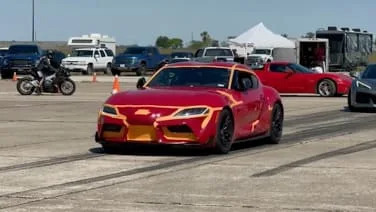3.0 Premium Launch Edition 3dr Coupe
2020 Toyota Supra
The new 2020 Toyota Supra is amazing, and by now its bold styling has begun to grow on me. It helps that the first one I drove proved to be an absolute blast on a tight and technical circuit, and this yellow example I’ve got now shows it to be a pleasant and compliant daily driver –– even on some pretty terrible broken concrete roads in my Southern California neighborhood. Much of this, of course, has to do with the underlying BMW-ness of this car, which rides on a shared platform and is built at the same Austrian plant that assembles the BMW Z4 convertible. That said, Toyota deserves a lot of credit for solid choices when it comes to the Supra’s distinct suspension tuning. Such variables as spring rates, damping force curves, steering effort mapping and bushing rates are invisible to the naked eye. But these factors will differ, not only because the Supra is lighter and has a fixed roof, but also because Toyota and BMW have different corporate priorities when it comes to ride and handling. We won’t see such calibration differences in the images that follow, but we will get to ogle the basic suspension architecture they both share. It’s obvious from here that the Supra uses a strut-type front suspension and has decent-sized four-piston fixed brake calipers. The other takeaway has to do with BMW’s strong influence, which is apparent in the use of wheel lug bolts instead of Toyota’s usual recipe of lug studs and lug nuts. And the BMW logos, of course. We’ll be seeing lots of those. Aluminum has been used extensively to reduce the front suspension’s mass, the main exception being the stabilizer bar (red) and the long link that connects it to the strut housing. The large hub carrier (green) is an especially nice-looking aluminum piece. But let’s ignore that for a moment and zero in on the dual pivot arrangement (yellow) that employs two lower links instead of a wishbone. A dual pivot arrangement is beneficial because it pushes the lower steering pivot point outward. The intersection of these two lines defines a virtual pivot point that, despite the distortion in this photo, lies somewhere within the brake rotor’s cooling vanes. Such a thing would be impossible with an A-shaped wishbone with a single ball joint. This has two benefits: it reduces the scrub radius by pushing the pivot axis closer to the center of the tire’s contact patch, and it increases the inclination of the steering pivot axis –– an imaginary line that extends upward from here to the top of the strut. But that’s the mechanics. The payoff is an improvement in the steering’s natural self-centering and straight tracking. The two links also have separate duties. The rearmost one (green) is square to the chassis and resists lateral loads, while the forward one (yellow) angles toward the front to locate the wheel in the fore-aft direction. The two steering pivots can’t stand too …
Full Review
The new 2020 Toyota Supra is amazing, and by now its bold styling has begun to grow on me. It helps that the first one I drove proved to be an absolute blast on a tight and technical circuit, and this yellow example I’ve got now shows it to be a pleasant and compliant daily driver –– even on some pretty terrible broken concrete roads in my Southern California neighborhood. Much of this, of course, has to do with the underlying BMW-ness of this car, which rides on a shared platform and is built at the same Austrian plant that assembles the BMW Z4 convertible. That said, Toyota deserves a lot of credit for solid choices when it comes to the Supra’s distinct suspension tuning. Such variables as spring rates, damping force curves, steering effort mapping and bushing rates are invisible to the naked eye. But these factors will differ, not only because the Supra is lighter and has a fixed roof, but also because Toyota and BMW have different corporate priorities when it comes to ride and handling. We won’t see such calibration differences in the images that follow, but we will get to ogle the basic suspension architecture they both share. It’s obvious from here that the Supra uses a strut-type front suspension and has decent-sized four-piston fixed brake calipers. The other takeaway has to do with BMW’s strong influence, which is apparent in the use of wheel lug bolts instead of Toyota’s usual recipe of lug studs and lug nuts. And the BMW logos, of course. We’ll be seeing lots of those. Aluminum has been used extensively to reduce the front suspension’s mass, the main exception being the stabilizer bar (red) and the long link that connects it to the strut housing. The large hub carrier (green) is an especially nice-looking aluminum piece. But let’s ignore that for a moment and zero in on the dual pivot arrangement (yellow) that employs two lower links instead of a wishbone. A dual pivot arrangement is beneficial because it pushes the lower steering pivot point outward. The intersection of these two lines defines a virtual pivot point that, despite the distortion in this photo, lies somewhere within the brake rotor’s cooling vanes. Such a thing would be impossible with an A-shaped wishbone with a single ball joint. This has two benefits: it reduces the scrub radius by pushing the pivot axis closer to the center of the tire’s contact patch, and it increases the inclination of the steering pivot axis –– an imaginary line that extends upward from here to the top of the strut. But that’s the mechanics. The payoff is an improvement in the steering’s natural self-centering and straight tracking. The two links also have separate duties. The rearmost one (green) is square to the chassis and resists lateral loads, while the forward one (yellow) angles toward the front to locate the wheel in the fore-aft direction. The two steering pivots can’t stand too …
Hide Full Review
Hide Full Review
Retail Price
$55,250
MSRP / Window Sticker Price
| Engine | 3.0L I-6 |
| MPG | 24 City / 31 Hwy |
| Seating | 2 Passengers |
| Transmission | 8-spd auto w/OD |
| Power | 335 @ 5000 rpm |
| Drivetrain | rear-wheel |
Smart Buy Program is powered by 





